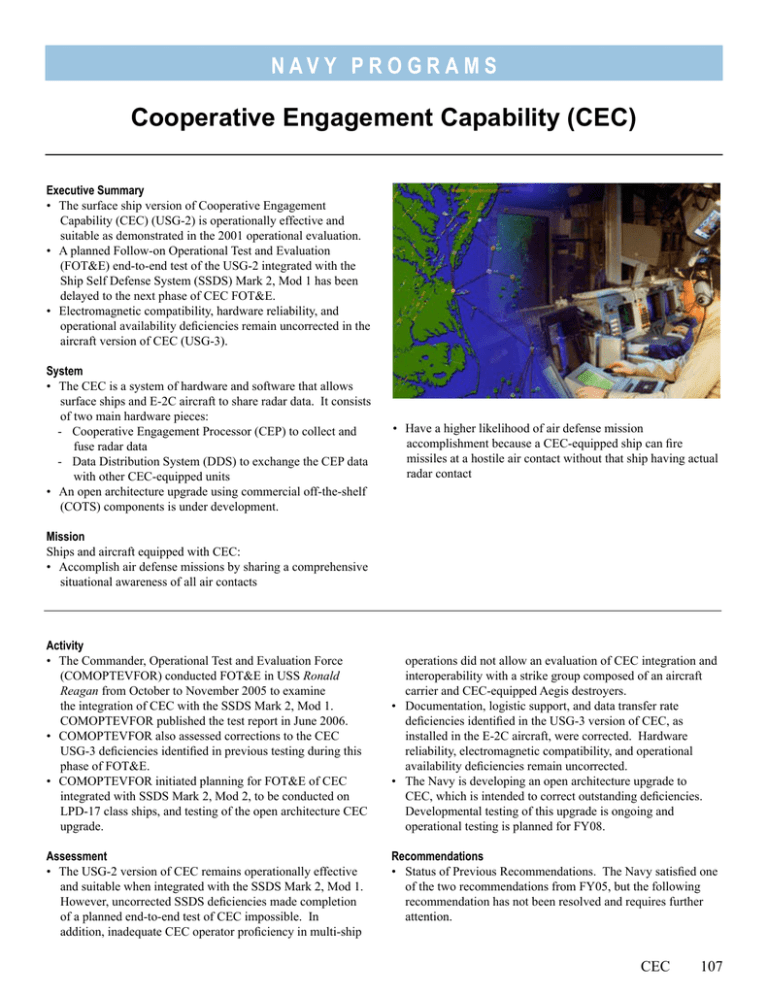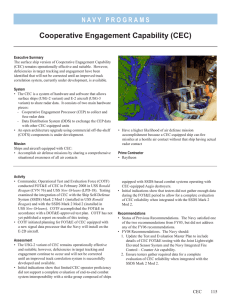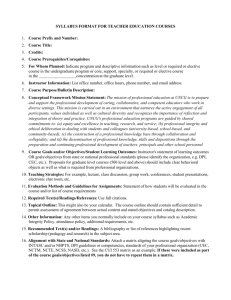Cooperative Engagement Capability (CEC)
advertisement

Navy P RO G R A M S Cooperative Engagement Capability (CEC) Executive Summary • The surface ship version of Cooperative Engagement Capability (CEC) (USG-2) is operationally effective and suitable as demonstrated in the 2001 operational evaluation. • A planned Follow-on Operational Test and Evaluation (FOT&E) end-to-end test of the USG-2 integrated with the Ship Self Defense System (SSDS) Mark 2, Mod 1 has been delayed to the next phase of CEC FOT&E. • Electromagnetic compatibility, hardware reliability, and operational availability deficiencies remain uncorrected in the aircraft version of CEC (USG-3). System • The CEC is a system of hardware and software that allows surface ships and E-2C aircraft to share radar data. It consists of two main hardware pieces: - Cooperative Engagement Processor (CEP) to collect and fuse radar data - Data Distribution System (DDS) to exchange the CEP data with other CEC-equipped units • An open architecture upgrade using commercial off-the-shelf (COTS) components is under development. • Have a higher likelihood of air defense mission accomplishment because a CEC-equipped ship can fire missiles at a hostile air contact without that ship having actual radar contact Mission Ships and aircraft equipped with CEC: • Accomplish air defense missions by sharing a comprehensive situational awareness of all air contacts Activity • The Commander, Operational Test and Evaluation Force (COMOPTEVFOR) conducted FOT&E in USS Ronald Reagan from October to November 2005 to examine the integration of CEC with the SSDS Mark 2, Mod 1. COMOPTEVFOR published the test report in June 2006. • COMOPTEVFOR also assessed corrections to the CEC USG-3 deficiencies identified in previous testing during this phase of FOT&E. • COMOPTEVFOR initiated planning for FOT&E of CEC integrated with SSDS Mark 2, Mod 2, to be conducted on LPD-17 class ships, and testing of the open architecture CEC upgrade. Assessment • The USG-2 version of CEC remains operationally effective and suitable when integrated with the SSDS Mark 2, Mod 1. However, uncorrected SSDS deficiencies made completion of a planned end-to-end test of CEC impossible. In addition, inadequate CEC operator proficiency in multi-ship operations did not allow an evaluation of CEC integration and interoperability with a strike group composed of an aircraft carrier and CEC-equipped Aegis destroyers. • Documentation, logistic support, and data transfer rate deficiencies identified in the USG-3 version of CEC, as installed in the E-2C aircraft, were corrected. Hardware reliability, electromagnetic compatibility, and operational availability deficiencies remain uncorrected. • The Navy is developing an open architecture upgrade to CEC, which is intended to correct outstanding deficiencies. Developmental testing of this upgrade is ongoing and operational testing is planned for FY08. Recommendations • Status of Previous Recommendations. The Navy satisfied one of the two recommendations from FY05, but the following recommendation has not been resolved and requires further attention. CEC 107 Navy P RO G R A M S FY05 #1: DOT&E recommended that the Navy continue to correct deficiencies from earlier testing. This recommendation remains valid. • FY06 Recommendation. The Navy should: 1. Ensure CEC operators are proficient in multi-ship operations prior to the next phase of FOT&E. 108 CEC 2. Update the Test and Evaluation Master Plan to include: ▪ Completion of the end-to-end test of CEC integrated with the SSDS Mark 2, Mod 1 ▪ FOT&E of CEC integrated with SSDS Mark 2, Mod 2 on LPD-17 class ships ▪ FOT&E of the CEC open architecture upgrade





